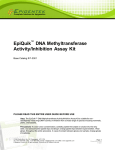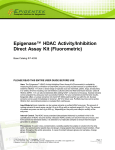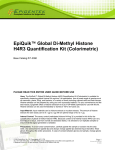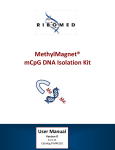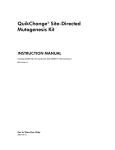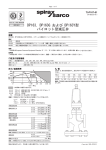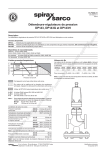Download EpiQuik ™ DNMT1 Assay Kit
Transcript
EPIGENTEK Complete Solutions for Epigenetics EpiQuik™ DNMT1 Assay Kit Base Catalog # P-3011 PLEASE READ THIS ENTIRE USER GUIDE BEFORE USE Uses: The EpiQuik™ DNMT1 Assay Kits are very suitable for measuring Dnmt amounts quantitatively from fresh tissue and cultured cells of human and mouse. 110 Bi County Blvd. Ste. 122, Farmingdale, NY 11735 Tel: 1-877-374-4368 ■ Fax: 1-718-484-3956 ■ E-mail: [email protected] ■ Web: www.epigentek.com © Epigentek Group Inc. All rights reserved. Products are for research use only. Page 1 Revised 2014-07-02 P-3011 EPIGENTEK Complete Solutions for Epigenetics KIT CONTENTS Component 48 Assays Cat. #P-3011-2 96 Assays Cat. #P-3011-3 Storage Upon Receipt D1 (10X Wash Buffer) 14 ml 28 ml 4°C D2 (Assay Buffer) 5 ml 10 ml 4°C D3 (DNMT1 Standard, 20 µg/ml)* 20 µl 40 µl –20°C D4 (Capture Antibody, 500 µg/ml)* 8 µl 16 µl 4°C D5 (Detection Antibody, 200 µg/ml)* 10 µl 20 µl –20°C D6 (Developing Solution) 6 ml 12 ml 4°C D7 (Stop Solution) 6 ml 11 ml RT Blocking Buffer 10 ml 20 ml 4°C 8-Well Assay Strips (with Frame) 6 12 4°C User Guide 1 1 RT * For maximum recovery of the products, centrifuge the original vial prior to opening the cap. SHIPPING & STORAGE The kit is shipped in two parts: one part at ambient room temperature, and the second part on frozen ice packs at 4°C. Upon receipt: (1) Store D3 and D5 at –20°C away from light; (2) Store D1, D2, D4, D6, Blocking buffer and the 8-Well Assay Strips at 4°C away from light; (3) Store all other components at room temperature. The kit is stable for up to 6 months from the shipment date, when stored properly. Note: (1) Check if wash buffer, D1, contains salt precipitates before using. If so, warm (at room temperature or 37°C) and shake the buffer until the salts are re-dissolved; (2) check if a blue color is present in D6 (Developing Solution), which would indicate contamination of the solution and should not be used. To avoid contamination, transfer the amount of D6 required into a secondary container (tube or vial) before adding D6 into the assay wells. MATERIALS REQUIRED BUT NOT SUPPLIED Adjustable pipette or multiple-channel pipette Multiple-channel pipette reservoirs Aerosol resistant pipette tips Microplate reader capable of reading absorbance at 450 nm 1.5 ml microcentrifuge tubes Incubator for 37°C incubation Distilled water 110 Bi County Blvd. Ste. 122, Farmingdale, NY 11735 Tel: 1-877-374-4368 ■ Fax: 1-718-484-3956 ■ E-mail: [email protected] ■ Web: www.epigentek.com © Epigentek Group Inc. All rights reserved. Products are for research use only. Page 2 Revised 2014-07-02 P-3011 EPIGENTEK Complete Solutions for Epigenetics Nuclear extracts Parafilm M or aluminum foil GENERAL PRODUCT INFORMATION Quality Control: Each lot of the EpiQuik™ DNMT1 Assay Kit is tested against predetermined specifications to ensure consistent product quality. Epigentek guarantees the performance of all products in the manner described in our product instructions. Product Warranty: If this product does not meet your expectations, simply contact our technical support unit or your regional distributor. We also encourage you to contact us if you have any suggestions about product performance or new applications and techniques. Safety: Suitable lab coat, disposable gloves, and proper eye protection are required when working with this product. Product Updates: Epigentek reserves the right to change or modify any product to enhance its performance and design. The information in this User Guide is subject to change at any time without notice. Thus, only use the User Guide that was supplied with the kit when using that kit. Usage Limitation: The EpiQuik™ DNMT1 Assay Kit is for research use only and is not intended for diagnostic or therapeutic applications. Intellectual Property: The EpiQuik™ DNMT1 Assay Kit and methods of use contain proprietary technologies by Epigentek. A BRIEF OVERVIEW Epigenetic inactivation of genes play a critical role in many important human diseases, especially in cancer. A core mechanism for epigenetic inactivation of the genes is methylation of CpG islands in genome DNA. Methylation of CpG islands involves the course in which DNA methyltransferases (Dnmts) transfer a methyl group from S-adenosyl-L-methionine to the fifth carbon position of the cytosines. At least three families of Dnmts have been identified in mammals now: DNMT1, Dnmt2, and Dnmt3. DNMT1 prefers to methylate cytosine residues in hemimethylated DNA. Increased activation or amount of DNMT1 is believed to be involved in carcinogenesis, and other genetic and epigenetic diseases. The major assay for measuring the expression or amount of DNMT1 protein currently is Western blot. This method requires electrophoresis and transfer process, which makes the assay inconvenient, time consuming, and has low throughput. The EpiQuik™ DNMT1 Assay Kit addresses these problems by using a unique procedure to measure the amount of DNMT1. The kit has the following features: Very rapid procedure, which can be finished within 3.5 hours. Innovative colorimetric assay to quantitatively measure the amount of DNMT1 without the need for electrophoresis. Strip microplate format makes the assay flexible: manual or high throughput analysis. Simple, reliable, and consistent assay conditions. 110 Bi County Blvd. Ste. 122, Farmingdale, NY 11735 Tel: 1-877-374-4368 ■ Fax: 1-718-484-3956 ■ E-mail: [email protected] ■ Web: www.epigentek.com © Epigentek Group Inc. All rights reserved. Products are for research use only. Page 3 Revised 2014-07-02 P-3011 EPIGENTEK Complete Solutions for Epigenetics PRINCIPLE & PROCEDURE The EpiQuik™ DNMT1 Assay Kit is designed for measuring total DNMT1 amount from tissues or cells. In an assay with this kit, the unique Dnmt affinity substrate is stably coated on the strip well. The sample is added into the well and DNMT1 contained in the sample binds to the substrate. The bound DNMT1 can be recognized with a specific DNMT1 antibody and colorimetrically quantified through an ELISA-like reaction. The amount of DNMT1 is proportional to the intensity of color development. 0.8 0.7 OD450 nm 0.6 0.5 0.4 0.3 0.2 0.1 0 0 5 10 15 20 25 30 35 40 Dnmt1 Standard (ng) Illustrated standard curve generated with DNMT1 Standard. Schematic procedure of the EpiQuik™ DNMT1 Assay Kit ASSAY PROTOCOL For the best results, please read the protocol in its entirety prior to starting your experiment. Starting Materials Input Amount: The amount of nuclear extracts for each assay can be between 1 µg and 20 ug with an optimal range of 5 to 10 µg. Nuclear Extraction: You can use your method of choice for preparing nuclear extracts from the treated and untreated samples. Epigentek also offers a nuclear extraction kit (Cat # OP-0002) optimized for use with this kit. Nuclear extracts should be stored at –80°C in aliquots until use. 110 Bi County Blvd. Ste. 122, Farmingdale, NY 11735 Tel: 1-877-374-4368 ■ Fax: 1-718-484-3956 ■ E-mail: [email protected] ■ Web: www.epigentek.com © Epigentek Group Inc. All rights reserved. Products are for research use only. Page 4 Revised 2014-07-02 P-3011 EPIGENTEK Complete Solutions for Epigenetics 1. Working Buffer and Solution Preparation a. Prepare Diluted D1 1X Wash Buffer: 48-Assay Kit: Add 13 ml of D1 10X Wash Buffer to 117 ml of distilled water and adjust pH to 7.2-7.5. 96-Assay Kit: Add 26 ml of D1 10X Wash Buffer to 234 ml of distilled water and adjust pH to 7.2-7.5. This Diluted D1 1X Wash Buffer can now be stored at 4°C for up to six months. b. Prepare Diluted D4 Capture Antibody Solution: Dilute D4 Capture Antibody with Diluted D1 1X Wash Buffer at a ratio of 1:500 (i.e., add 1 µl of D4 to 500 µl of Diluted D1). 50 µl of Diluted D4 will be required for each assay well. c. Prepare Diluted D5 Detection Antibody Solution: Dilute D5 Detection Antibody with Diluted D1 1X Wash Buffer at a ratio of 1:2000 (i.e., add 1 µl of D5 to 2000 µl of Diluted D1). 50 µl of Diluted D5 will be required for each assay well. d. Prepare Diluted DNMT1 Standard: Suggested Standard Curve Preparation: First, dilute D3 DNMT1 Standard with D2 to the concentrations of 1, 2, 5, 10 and 20 ng/µl according to the following dilution chart: Tube D3 (20 ng/µl) D2 Resulting D3 Concentration 1 1.0 µl 19.0 µl 1 ng/µl 2 1.0 µl 9.0 µl 2 ng/µl 3 1.0 µl 3.0 µl 5 ng/µl 4 2.0 µl 2.0 µl 10 ng/µl 5 4.0 µl 0.0 µl 20 ng/µl Note: Keep each of the diluted solutions except D1 1X Wash Buffer on ice until use. Any remaining diluted solutions other than Diluted D1 should be discarded if not used within the same day. 2. DNMT1 Binding a. Predetermine the number of strip wells required for your experiment. It is advised to run replicate samples (include blank and positive controls) to ensure that the signal generated is validated. Carefully remove un-needed strip wells from the plate frame and place them back in the bag (seal the bag tightly and store at 4°C). b. Blank Wells: Add 100 µl of D2 to each blank well. c. Standard Wells: Add 98 µl of D2 and 2 µl of Diluted DNMT1 Standard to each standard well with a minimum of five wells, each at a different concentration between 2 and 40 ng/µl (based on the dilution chart in Step 1e; see Table 2 as an example). d. Sample Wells: Add 94 to 98 µl of D2 and 2 to 6 µl of your nuclear extracts to each sample well. Total volume should be 100 µl per well. 110 Bi County Blvd. Ste. 122, Farmingdale, NY 11735 Tel: 1-877-374-4368 ■ Fax: 1-718-484-3956 ■ E-mail: [email protected] ■ Web: www.epigentek.com © Epigentek Group Inc. All rights reserved. Products are for research use only. Page 5 Revised 2014-07-02 P-3011 EPIGENTEK Complete Solutions for Epigenetics Note: (1) Follow the suggested well setup diagrams on page 12; (2) It is recommended to use 5 µg to 10 µg of nuclear extract per well. e. Cover strip-well microplate with Parafilm M or aluminum foil to avoid evaporation and incubate at 37°C for 90 to 120 min. f. Remove the reaction solution from each well. Add 150 µl of Blocking Buffer to each well, then cover with Parafilm M or aluminum foil and incubate at 37°C for 30 min. g. Remove the Blocking Buffer from each well. Wash each well three times with 150 µl of the Diluted D1 1X Wash Buffer each time. 3. Antibody Binding & Signal Enhancing a. Add 50 µl of the Diluted D4 to each well, then cover with Parafilm M or aluminum foil and incubate at room temperature for 60 min. b. Remove the Diluted D4 solution from each well. c. Wash each well three times with 150 µl of the Diluted D1 each time. d. Add 50 µl of the Diluted D5 to each well, then cover with Parafilm M or aluminum foil and incubate at room temperature for 30 min. e. Remove the Diluted D5 solution from each well. f. Wash each well four times with 150 µl of the Diluted D1 each time. Note: Ensure any residual wash buffer in the wells is removed as much as possible at each wash step. 4. Signal Detection a. Add 100 µl of D6 to each well and incubate at room temperature for 1 to 10 min away from light. Begin monitoring color change in the sample wells and control wells. The D6 solution will turn blue in the presence of sufficient demethylated products. b. Add 100 µl of D7 to each well to stop enzyme reaction when color in the positive control wells turns medium blue. Mix the solution by gently shaking the frame and wait 1-2 min to allow the color reaction to be completely stopped. The color will change to yellow after adding D7 and the absorbance should be read on a microplate reader within 2 to 10 min at 450 nm with an optional reference wavelength of 655 nm. Note: (1) Most microplate readers have the capability to carry out dual wavelength analysis and will automatically subtract reference wavelength absorbance from the test wavelength absorbance. If your plate reader does not have this capability, the plate can be read twice, once at 450 nm and once at 655 nm. Then, manually subtract the 655 nm ODs from 450 nm ODs; (2) If the strip-well microplate frame does not fit in the microplate reader, transfer the solution to a standard 96-well microplate. 5. DNMT1 Calculation a. Calculate the average duplicate readings for the sample wells and blank wells. b. Calculate % DNMT1 change using the following formula: 110 Bi County Blvd. Ste. 122, Farmingdale, NY 11735 Tel: 1-877-374-4368 ■ Fax: 1-718-484-3956 ■ E-mail: [email protected] ■ Web: www.epigentek.com © Epigentek Group Inc. All rights reserved. Products are for research use only. Page 6 Revised 2014-07-02 P-3011 EPIGENTEK Complete Solutions for Epigenetics DNMT1 Change% = Treated (Tested) Sample OD – Blank OD x 100% Untreated (Control) Sample OD – Blank OD Example calculation: Average OD450 of treated sample is 0.5 Average OD450 of untreated control is 0.9 Average OD450 of blank is 0.1 DNMT1 change % = (0.5 – 0.1) x 100% = 50% 0.9- 0.1 For Detailed Quantification : 1. 2. Generate a standard curve and plot OD value versus amount of D3 Standard at each concentration point. Determine the slope as OD/ng (you can use Microsoft Excel statistical functions for slope calculation), then calculate the amount of DNMT1 using the following formula: (Sample OD – Blank OD) DNMT1 (ng/mg protein ) = x 1000 Slope x Protein Amount (ug*) *Nuclear extract added into sample wells at Step 2d. SUGGESTED BUFFER AND SOLUTION SETUP Table 1. Approximate amount of required buffers and solutions for defined assay wells based on the protocol. Reagents 1 well 1 strip (8 wells) 2 strips (16 wells) 6 strips (48 wells) 12 strips (96 wells) Diluted D1 2.5 ml 20 ml 40 ml 120 ml 240 ml D2 100 µl 800 µl 1600 µl 4900 µl 9600 µl Blocking Buffer 0.15 ml 1.2 ml 2.5 ml 7.5 ml 14.5 ml D3 Standard control N/A N/A 4 µL (optional) 8 µl 8 µl Diluted D4 50 µl 400 µl 800 µl 2400 µl 4800 µl Diluted D5 50 µl 400 µl 800 µl 2400 µl 4800 µl D6 0.1 ml 0.8 ml 1.6 ml 4.8 ml 9.6 ml D7 0.1 ml 0.8 ml 1.6 ml 4.8 ml 9.6 ml 110 Bi County Blvd. Ste. 122, Farmingdale, NY 11735 Tel: 1-877-374-4368 ■ Fax: 1-718-484-3956 ■ E-mail: [email protected] ■ Web: www.epigentek.com © Epigentek Group Inc. All rights reserved. Products are for research use only. Page 7 Revised 2014-07-02 P-3011 EPIGENTEK Complete Solutions for Epigenetics SUGGESTED STRIP WELL SETUP Table 2. The suggested strip-well plate setup for Dnmt1 quantification in a 48-assay format (in a 96-assay format, Strips 7 to 12 can be configured as Sample). The controls and samples can be measured in duplicate. Well # A B C D E F G H Strip 1 Blank D3 2 ng D3 4ng D3 10 ng D3 20 ng D3 40 ng Sample Sample Strip 2 Blank D3 2 ng D3 4ng D3 10 ng D3 20 ng D3 40 ng Sample Sample Strip 3 Sample Sample Sample Sample Sample Sample Sample Sample Strip 4 Sample Sample Sample Sample Sample Sample Sample Sample Strip 5 Sample Sample Sample Sample Sample Sample Sample Sample Strip 6 Sample Sample Sample Sample Sample Sample Sample Sample TROUBLESHOOTING Problem Possible Cause Suggestion No signal or weak signal in both the positive control and sample wells Reagents are added incorrectly. Check if reagents are added in the proper order with the right amount, and if any steps in the protocol may have been omitted by mistake. Incubation time and temperature are incorrect. Ensure the incubation time and temperature described in the protocol are followed correctly. Incorrect absorbance reading. Check if appropriate absorbance wavelength (450 nm) is used. Kit was not stored or handled properly. Ensure all components of the kit were stored at the appropriate temperature and the cap is tightly capped after each opening or use. The standard amount is insufficiently added to the well in Step 2c. Ensure a sufficient amount of standard is added. The standard is degraded due to improper storage conditions. Follow the Shipping & Storage guidance in this User Guide for storage of D3 DNMT1 Standard. Insufficient washing of wells. Check if washing recommendations at each step is performed according to the protocol. Contaminated by sample or standard. Ensure the well is not contaminated from adding sample or standard accidentally or from using contaminated tips. Incubation time with Diluted D5 is too long. The incubation time at Step 3d should not exceed 90 min. No signal or weak signal in only the standard curve wells High background present in the blank wells 110 Bi County Blvd. Ste. 122, Farmingdale, NY 11735 Tel: 1-877-374-4368 ■ Fax: 1-718-484-3956 ■ E-mail: [email protected] ■ Web: www.epigentek.com © Epigentek Group Inc. All rights reserved. Products are for research use only. Page 8 Revised 2014-07-02 P-3011 EPIGENTEK Complete Solutions for Epigenetics No signal or weak signal only in sample wells Uneven color development Large variation between replicate wells Over-development of color. Decrease the development time in Step 4a before adding D6 Stop Solution in Step 4b. Protein sample is not properly extracted or purified. Ensure your protocol is suitable for histone protein extraction. For the best results, it is advised to use Epigentek’s Nuclear extraction Kit (Cat. No. OP0002). Sample amount added into the wells is insufficient. Ensure a sufficient amount of nuclear extracts is used as indicated in Step 2. The sample can be titrated to determine the optimal amount to use in the assay. Sample was not stored properly or has been stored for too long. Ensure sample is stored in aliquots at – 80°C, with no more than 6 months nuclear extracts. Little or no DNMT1 in the sample. This problem may be a result of many factors. If the affecting factors cannot be determined, use new or re-prepared nuclear extracts. Insufficient washing of the wells. Ensure the wells are washed according to the guidance of washing and residue washing buffer is removed as much as possible. Delayed color development or delayed stopping of color development in the wells. Ensure color development solution or stop solution is added sequentially and is consistent with the order you added the other reagents (e.g., from well A to well G or from well 1 to well 12). Color reaction is not evenly stopped due to an inconsistency in pipetting time. Ensure D6 Developer Solution and D7 Stop Solution are added at the same time between replicates or otherwise maintain consistent timing between each addition of solutions. Color reaction is not evenly stopped due to an inconsistent order when adding solutions. Ensure all solutions, particularly D6 Developer Solution and D7 Stop Solution, are added in the same order each time as all other solutions. The solutions are not evenly added due to an inconsistency in pipetting volume. Ensure the solution in each pipette tip is equal in the multi-channel pipette. Equilibrate the pipette tip in any solutions before adding them. Ensure the solutions, especially those with small volumes (ex: 1 ul) are completely added into the wells. Solutions or antibodies were not actually added into the wells. Do not allow pipette tip to touch the outer edges or inner sides of the wells in order to prevent solutions from sticking to the surface. 110 Bi County Blvd. Ste. 122, Farmingdale, NY 11735 Tel: 1-877-374-4368 ■ Fax: 1-718-484-3956 ■ E-mail: [email protected] ■ Web: www.epigentek.com © Epigentek Group Inc. All rights reserved. Products are for research use only. Page 9 Revised 2014-07-02 P-3011 EPIGENTEK Complete Solutions for Epigenetics Did not sufficiently shake the solutions in the wells evenly after adding D7 Stop Solution in Step 5b. Gently shake the plate frame across a flat surface so that the solutions in the wells are better distributed. Do not stir. Did not use the same pipette device throughout the experiment. Use the same multi-channel pipette device throughout the entire experiment, as different pipette devices may have slight variations in performance. RELATED PRODUCTS Nuclear Extract Preparation OP-0006 EpiQuik™ Nuclear Extraction Kit DNA Methyltransferase Activity/Inhibition Assay P-3009 EpiQuik™ DNMT Activity/Inhibition Assay Ultra Kit (Colorimetric) P-3010 EpiQuik™ DNMT Activity/Inhibition Assay Ultra Kit (Fluorometric) P-3012 EpiQuik™ DNMT3A Assay Kit P-3013 EpiQuik™ DNMT3B Assay Kit 110 Bi County Blvd. Ste. 122, Farmingdale, NY 11735 Tel: 1-877-374-4368 ■ Fax: 1-718-484-3956 ■ E-mail: [email protected] ■ Web: www.epigentek.com © Epigentek Group Inc. All rights reserved. Products are for research use only. Page 10 Revised 2014-07-02 P-3011













